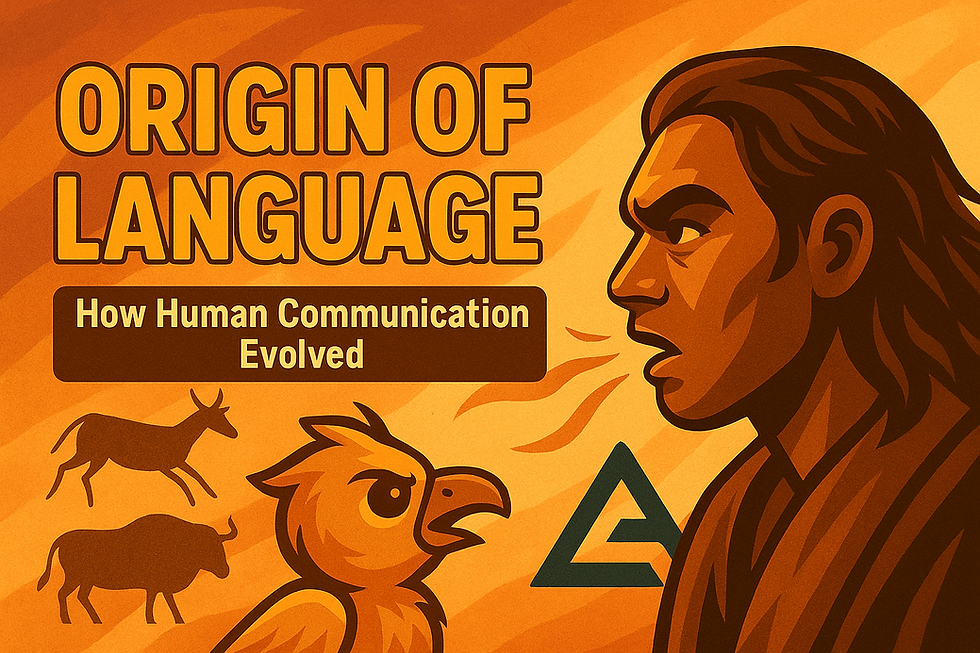Origin of Language: How Human Communication Evolved
- James Pite
- Aug 18
- 3 min read

Why Explore Language Origins?
Language defines us. It lets you express ideas, build relationships, and solve problems. Have you wondered how it started? Understanding its roots sharpens your skills in tasks like writing a financial aid appeal letter or using a cover letter writing service. This guide reveals key theories, updated with 2025 research, and shows practical links to everyday writing.
Key Approaches to Language Evolution
Scholars debate how language emerged. Most favour continuity theories, where it is built gradually from primate systems. Others see sudden leaps. Here’s a breakdown:
Continuity Theories: Language evolved from pre-linguistic systems in ancestors. Recent studies show chimpanzees combine calls for new meanings, hinting at shared roots.
Discontinuity Theories: Language appeared abruptly in human evolution. Noam Chomsky links it to a single change around 100,000 years ago.
Innate vs. Learned: Some view it as genetic; others as cultural, learned through interaction. 2025 research ties a specific gene to spoken language emergence.
Gestural Precursors: Early communication likely started with gestures, evolving into vocal forms. Tool use and brain lateralization support this, dating back 1.75 million years.
These views matter. They explain why clear structure in writing a character letter for court builds trust, mirroring evolutionary social bonds.
Timeline of Language Development
Language traces back far. Fossil and genetic evidence pinpoints milestones:
2.5 Million Years Ago: Homo habilis shows early symbolic potential through tools.
1.8 Million Years Ago: Homo erectus may have used proto-language.
135,000 Years Ago: Full language capacity existed in Homo sapiens, per 2025 analysis.
100,000 Years Ago: Widespread use began, coinciding with behavioral modernity.
35,000 Years Later: Language spread globally, enabling complex societies.
Fun fact: Even with limited input, children acquire language, as shown in 2025 studies. This resilience aids tasks like parents writing letters to teachers, where simple words convey intent.
Major Hypotheses on Language Origins
Early ideas were playful; modern ones draw from science. Here are prominent ones:
Bow-Wow Theory: Words imitated natural sounds. Outdated, but echoes in onomatopoeia.
Pooh-Pooh Theory: Emotional exclamations formed first words.
Ding-Dong Theory: Natural resonances inspired sounds.
Yo-He-Ho Theory: Rhythmic labour chants led to speech.
Gossip and Grooming: Robin Dunbar suggests language replaced grooming for social bonds.
Ritual/Speech Coevolution: Language tied to rituals building trust, per recent multimodal theories.
Iconic Origins: Steven Mithen’s 2024 book argues for sound-symbol links in early speech.
2024-2025 updates emphasise multimodal evolution: gestures, sounds, and tools combined. A gene variant unique to humans may have sparked vocal language.
Challenges in Language Evolution
Why did language succeed? Signals must be reliable:
Reliability Issue: Animals use hard-to-fake cues. Humans trust "cheap" words due to social structures.
Mother Tongues Hypothesis: Started with kin, building trust gradually.
Reciprocal Altruism: Honesty enforced through mutual benefits.
Social Transformation: High trust from rituals enabled symbolic speech.
These solve why deception didn’t derail language. Apply this: In writing a letter to a judge, honesty builds credibility, echoing evolutionary trust.
Modern Insights and Applications
Recent findings reshape views:
Chimp calls show compositionality, bridging to human syntax.
Indo-European roots trace back 8,000 years, per 2024 archaeology.
Mind-reading tech decodes thoughts to speech, highlighting brain-language links.
Universal pain signals suggest innate elements.
How does this help you? Knowing origins improves communication. For how to write a noise complaint letter, use clear, rhythmic structure, mirroring early vocal grooming. In a letter writing service, evolutionary insights ensure persuasive, trust-building content.
Tips to Apply Language Evolution in Writing
Boost your skills with these steps:
Build Trust: Start with honest signals, like facts in a demand letter for personal injury.
Use Gestures in Words: Descriptive language mimics early icons, vital for how to write a letter of recommendation for citizenship.
Keep It Rhythmic: Short sentences flow, as in ancient chants—perfect for a keepsake letter to a grandchild.
Adapt to Context: Tailor like social evolution; formal for court, warm for family.
Seek Help: A cover letter writing service uses these principles for standout results.
Unlock Better Communication
Language evolved from survival needs to complex expression. Grasp its origins, and you transform your writing. Whether drafting a financial aid appeal letter or exploring roots, these insights connect past to present.
Ready for impact? Use a letter writing service to apply evolutionary clarity in your next document.





Comments